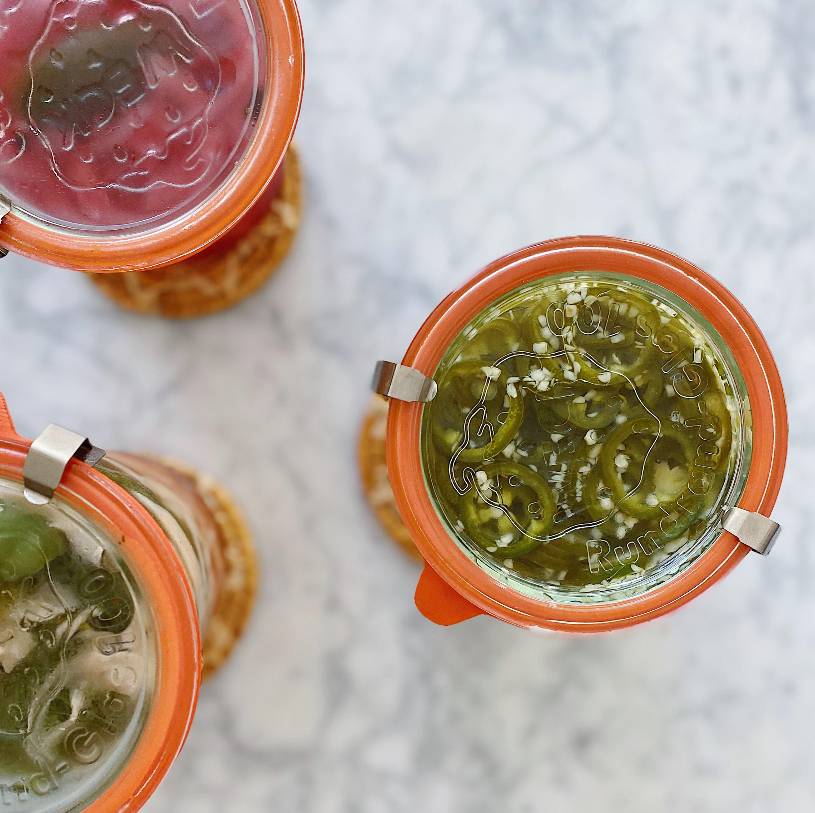Quick Pickling 101
Quick-pickles have quickly become a staple in my refrigerator. From red onions, to fennel, to even peaches, you can truly pickle almost anything.
They can be enjoyed as they are (they actually wake up your palette, so they're a great thing to snack on before a meal!) and they instantly elevate even the most basic dish. They're full of tangy, briny flavors and I just can't get enough!
Admittedly, I used to be sort of afraid of pickling and thought it required a ton of work. Spoiler alert: I was wrong! After learning about this method of quick pickling in culinary school and being the resident pickler at my Octavia externship (kidding, but I did pickle a tonnn of veggies during my four months there!), I am very confident in my quick-pickling skills and am excited to share some tips, tricks and best practices.
Choosing the Right Thing to Pickle
As I mentioned above, you can pretty much pickle any fruit or veggie. That said, there are some things that taste better pickled than others.
As a rule of thumb, most vegetables that are pleasant to eat raw will taste amazing pickled, especially vegetables that are on the crunchy side. In terms of fruit, I like to pickle firmer fruits with a bit more texture (i.e. apples, asian pears, stone fruit, etc.). There are some softer fruits/vegetables that are also good pickled, but I tend to gravitate more toward anything with a bit of a crunch.
Below are some examples that fall in the "do pickle" category to help guide you. I'm just sharing what has worked the best in my experience but I definitely encourage experimenting (and please share any success stories in the comments!).
Veggies: Carrots (I especially love pickling baby carrots because they're more tender), fennel, cucumbers, kohlrabi, green beans, cauliflower, any type of sweet or hot pepper, zucchini, red onions, shallots, radishes, celery, cabbage, ramps.
Fruits: Apples, pears, fuyu persimmons, most stone fruits (peaches, plums, nectarines, cherries), pineapples.
The Ratio
The classic ratio is super easy to remember and is easily scale-able depending on how many pickles you're making. It's 100% vinegar, 50% water, 25% sugar and 12.5% kosher salt by weight. So for example, 200g vinegar, 100g water, 50g sugar and 25g kosher salt (again, you can scale this up or down!).
You might be asking, "can I use this same ratio but instead of weighing the ingredients, can I just measure them out by volume?" Unfortunately, you do need to weigh the ingredients for this recipe and here's why: 1 cup of water does not weigh the same as 1 cup of sugar, for example. So if I were to apply the percentage ratio to volume instead of weight, I would end up with a funky ratio.
Example: 1 cup vinegar, 1/2 cup water, 1/4 cup sugar and 1/8 cup kosher salt ends up being about 250g vinegar, 112.5g water, 50g sugar and 36g kosher salt by weight. As you can see, this doesn't result in the 100% / 50% / 25% / 12.5% ratio but rather a 100% / 45% / 20% / 14% ratio and the end product will be a bit off-balance.
All of that said, I recommend purchasing a kitchen scale regardless of whether you plan to do a ton of picking - it's great to have on hand for any recipes that call for weight measurements and it's a serious go-to in my kitchen! I have and love this one (and it's under $10!).
Choosing the Right Vinegar
I recommend using Champagne vinegar, any white wine vinegar or rice vinegar when pickling. They all have a softer, less harsh flavor than a distilled white vinegar and will result in a more nuanced flavor in your pickles.
That said, I'll use whatever vinegar I have on hand to pickle. Just last week, I used red wine vinegar to pickle some red onions and I also love using apple cider vinegar in some cases (it's great for pickled fennel and apples). You can also mix and match different vinegars, as long as you stick to the overall vinegar ratio. The only vinegars I stay away from for pickling are distilled white and balsamic.
A good rule of thumb is that a more substantial, bold fruit or vegetable can take a more substantial, bold vinegar. I recommend choosing a milder rice or white wine vinegar when pickling pears or pineapple but could use something bolder such as red wine vinegar to pickle onions or cauliflower.
One quick thing to caveat is that if you use red wine or sherry vinegar, it can give a soft pink hue to your pickles. Not always a bad thing (especially when pickling something like red onions), but worth calling out!
Adding Aromatics
I recommend always adding aromatics (spices, herbs, etc.) to your pickles - they impart such great depth of flavor and it's fun to get creative with different flavor combos. Have fun with it!
If I'm making pickled jalapeno peppers for a taco night, I might add a crushed garlic clove, a few sprigs of cilantro, lime peel and a pinch of cumin seeds to the jar. If I'm doing pickled onions for a salmon bowl, I might add a nub of crushed ginger and a jalapeno cut in half. If I'm making pickled carrots to top off a salad, I might add some fresh dill, mustard seeds and peppercorns. This just gives you an idea of the possibilities - the flavor combos are seriously endless.
Below are some of my favorite aromatics to add to pickles:
Spices: Black peppercorns, coriander seeds, cumin seeds, mustard seeds, bay leaves, all spice, cloves, red pepper flakes, marash chili flakes, star anise, caraway seeds, fennel seeds
Fresh Herbs: dill, mint, tarragon, cilantro
Other Fresh Aromatics: ginger, garlic, halved chili peppers (I like using serrano, jalapeno or fresno), fennel fronds, citrus peel (lemon, lime, orange)
INGREDIENTS
Scale quantities to your preference/need using the ratios listed under “method” section.
Vinegar
Water
Sugar
Kosher Salt
METHOD
Measure out your ingredients into a non-reactive saucepan, following the 100% vinegar / 50% water / 25% sugar / 12.5% kosher salt ratio. The size of the saucepan you use will vary depending on how big or small you scale the recipe.
Whisk the mixture together and turn on the burner to medium heat. Bring the mixture up to a very gently simmer, stirring every once in a while to prevent the sugar/salt from collecting at the bottom of the pan. Once the sugar and salt dissolve, turn off the heat.
Pour the warm liquid over your prepped veggies/fruit and aromatics of choice. Allow to sit at room temp for about 2 hrs and then transfer to the fridge for at least a day and up to 3 weeks. Make sure your container is air-tight.
NOTES
I find that for a medium red onion, 200g vinegar, 100g water, 50g sugar and 25g salt is the perfect amount of pickling liquid!
I like to slice my pickled things relatively thinly using a mandolin (you definitely don't need one but it helps make the prep go by quickly!). The thinner you slice whatever you're pickling, the faster it will pickle - a thinly sliced onion will take less time to pickle than a big floret of cauliflower, for example.
If you're pickling something that you're cutting into larger pieces or that might be a little tough to chew (i.e. a large piece of carrot or large cauliflower floret), you can quickly blanch them in boiling salted water prior to pouring the pickling brine over them.
Similar to how you wouldn't want to cook two different types of pasta with different cooking times in the same pot, you don't want to pickle different types of fruits and veggies in the same container. A peach slice will pickle at a much faster rate than a carrot, for example.
I have specified using non-reactive pot (stainless steel, ceramic). This is because if you use anything made of reactive metal (cast iron, aluminum, unlined copper) the acid in the vinegar will cause a reaction with the metal and your pickling liquid will be imparted with a metallic/tin-like flavor.
If you end up making extra brine, you can store it in the refrigerator and use for a different batch of pickles.
You don't need to use warm pickling liquid straight from the pot - you could also cool it before use. A warm brine will pickle everything a little quicker and it's also better for helping break down a vegetable or fruit that's more fibrous or tough to begin with.
Special Equipment
I mentioned this above, but I love a good kitchen scale and you need one to follow this method.
I love this mandolin for thinly + uniformly slicing whatever I'm pickling. This is the one I use (and love!).
I pickle most of my stuff in quart size deli containers or these Weck jars but use whatever airtight container you have at home! A square/rectangular Tupperware will work in a pinch!
Veg/Fruit + Vinegar + Aromatic Combo Ideas
Red onions + mixture of red wine and champagne vinegar + black peppercorns, fresno chili
Cauliflower + rice vinegar + ginger, garlic and fresno chili
Apples + apple cider vinegar + fennel fronds, coriander seeds
Fennel + champagne vinegar + fresh dill, garlic and fresno chili
Pineapple + rice vinegar + star anise and orange peel
Peaches + white wine vinegar + cloves and ginger
Asian Pear + rice vinegar + allspice
Cucumbers + rice vinegar + ginger, marash chili flakes
Kirby cucumbers + white wine vinegar + dill, caraway seeds, peppercorns (classic dill pickle combo!)
Ideas for Using your Pickles
Pickled jalapeno or red onion for your next taco night
Pickled anything to toss into salads (one of my favorite local Greek spots, Souvla, does a really great salad topped with chicken, orange segments and pickled red onion that I love to mimic at home!)
Pickled apples and fennel tossed with greens, a pinch of salt, a little EVOO and lemon juice to top off grilled pork chops
Mixture of pickled baby carrot, green beans and cauliflower to snack on before dinner
Thinly sliced pickled peaches to mix in with fresh (non-pickled) peaches, basil, burrata, EVOO and sea salt for a refreshing summer salad
Pickled fennel on top of sliced citrus with watercress, olive oil and roasted almonds (made this here!)
Pickled shallot on a fried chicken sandwich (or really any sandwich!)
Thinly sliced pickled cucumbers to top off a salmon bowl
Pickled asian pear tossed into a slaw with cabbage, shaved carrots, toasted nuts and radishes
Pickled jalapeno slices to garnish a spicy margarita
Pickled baby carrot, celery, and/or pearl onions to garnish a Bloody Mary
Pickling liquid can be tossed into salad dressings, dips, marinades, mixed drinks (hello Bloody Mary!), etc. to add a slightly sweet + salty + tangy flavor!
If you made it this far, you're a champ! It's impossible to cover absolutely everything but I hope this becomes a helpful guide to pickling at home. Let me know what sorts of creations + flavor combinations you come up with and happy pickling!


